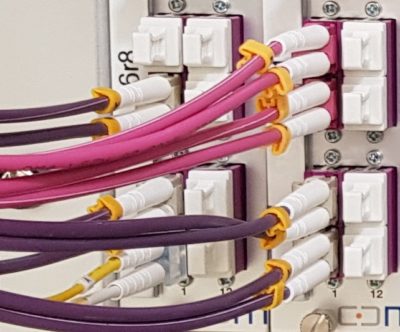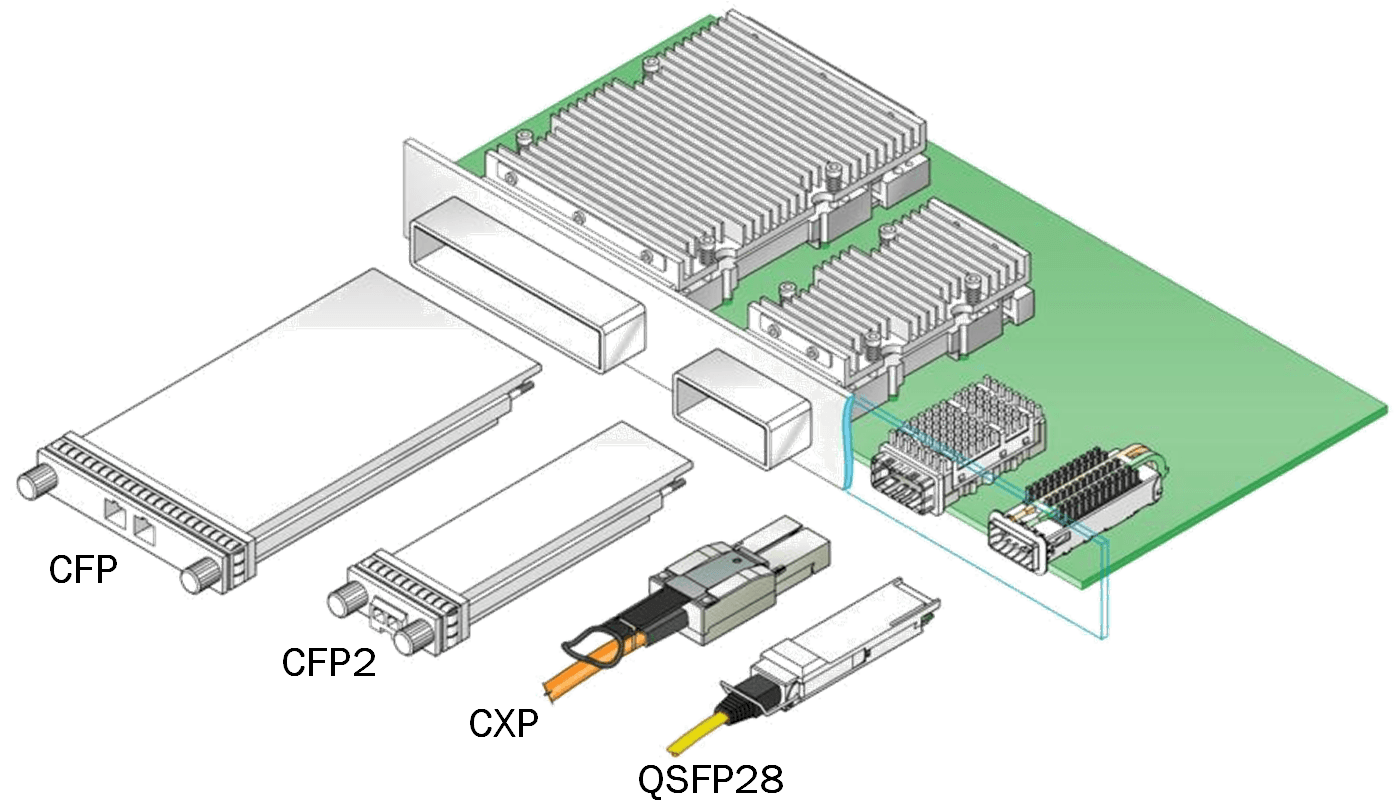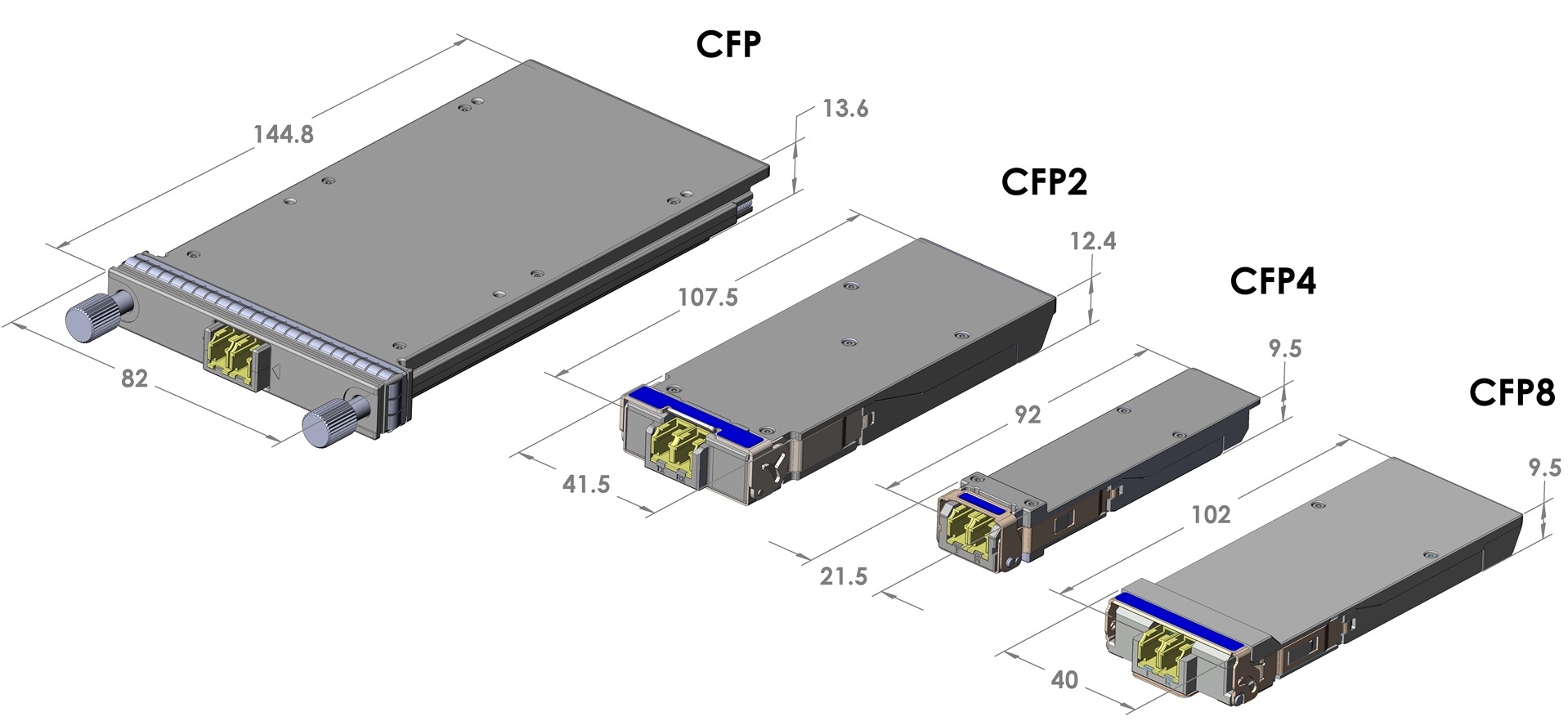At the time of the 400Gb Ethernet interfaces introduction, here is a summary of the different form-factors, transceivers and modules available for 100Gb Ethernet on Cisco devices.
As you will see below, there are many different types of 100Gb Ethernet transceivers. And each type have its own functional mode. In a next article, I will try to explain the differences between them and will give more details about the most common: the QSFP-28.
Form Factors
Here is a view of the different form factors – except the Cisco-proprietary form factor CPAK – available for 100Gb, in one image (Source: https://fmad.io/blog-100g-ethernet.html):
(Click on the image to see a larger version)
QSFP (QSFP28)
Today, the Quad Small Form-factor Pluggable (QSFP) is the primary way of delivering 100Gb Ethernet today. More specifically, we use the QSFP28 ( 4 x 28 Gbit/s QSFP+) standard to carry 100 Gigabit Ethernet.
The QSPF-28 form-factor is very common because when the QSFP+ 40Gb bi-directional (BiDi) transceiver was released, it enabled the data centers to upgrade from 10Gb to 40Gb without the need to replace fiber infrastructure. Then, the next generation dual-rate BiDi, which has both 40Gb and 100Gb operational modes, offers the same benefits. In the future, we can imagine the QSFP will remains for a long time, as the QSFP-DD (double density) is the next generation QSFP for 400Gb Ethernet.
Cisco QSFP28 modules work in the following Cisco networking equipment: Catalyst 9000 switches, Nexus 7000, 7700, 9000 Series switches, Cisco UCS servers, NCS 1000, 2000, 5000, 5500, 6000 Series Routers,
ASR 1K and 9K Series Router, and cBR-8 Converged Cable Access Router.
Optical / Direct attach Connectors
The QSFP28 transceiver can present different types of connectors:
- LC connectors for single-mode (SMF) optics or multi-mode (MMF) optics.
- MPO-12 connectors for multi-mode (MMF) optics.
- QSFP Direct attach with passive copper cable (DAC).
- QSFP Direct attach with active optical cable (AOC).
- QSFP Breakout cables with passive copper splitter cable. For example, for QSTP28 to 4xSFP+ direct attach cable.
Electrical Connector
- The QSFP transceiver has 38 pins, including 4 high-speed TX pairs and 4 high-speed RX pairs on the equipment side.
Power Classes and Maximum Power Consumption
- QSFP28 modules are categorized into several power classes, from 1 to 7, with a maximum power dissipation from 1,5W to 5W per module.
Thermal Requirements
The QSFP28 module operate within one of the temperature ranges defined below:
- Standard class: 0°C through 70°C (32°F to 158°F).
- Extended class: -5°C through 85°C (23°F 185°F).
- Industrial class: -40°C through 85°C (-40°F to 185°F).
Except specified, all Cisco QSFP transceivers are operating on the standard class.
Exceptions:
- The Cisco transceiver QSFP-100G-SM-SR is called 100GBASE CWDM4 Lite QSFP Transceiver, because its operating temperature range is from +10°C to +60°C. The price of this transceiver is around 3 times less than the QSFP-100G-CWDM4-S operating in the standard temperature class, and fully compatible.
- The Cisco transceiver QSFP-40/100-SRBD have also an operational temperature range from +10°C to +60°C.
Note: the storage temperature range is from -40°C to 85°C (-40 to 185°F).
More specifications
You can find all the details of the QSFP28 (SFF-8679) electrical specifications here.
CFP / CFP2 / CFP4 / CFP8
The C form-factor pluggable (CFP) is a multi-source agreement to produce a common form-factor for the transmission of high-speed digital signals. The “C” stands for the Latin letter C used to express the number 100 (centum), since the standard was primarily developed for 100 Gigabit Ethernet systems (source: Wikipedia).
Cisco is using CFP form-factors in the CRS and Nexus 7K platforms. And CFP2 form-factors in some line-cards for Nexus 9K3 and 9K5 switches, and also on the ASR9K platform.
(Click on the image to see a larger version)
Connectors
On Cisco devices, the CFP-100G modules are using:
- SC/PC connector on CFP-100G-LR4 and CFP-100G-ER4 modules.
- 24-fiber MPO/MTP connector on the CFP-100G-SR10 module.
Power Classes and Maximum Power Consumption
- The maximum power consumption per Cisco CFP module is 24W (12W for the SR10).
Thermal Requirements
- The operating temperature range is between 0°C and 70°C (32°F and 158°F).
- The storage temperature range: -40 to 85° C (-40 to 185° F)
Specifications
You can find the specifications of CFP/MSA here.
CPAK
The CPAK is a Cisco-proprietary form factor developed in order to provide a more power and space-efficient 100GbE optic compared to the CFP or CFP2 modules. Cisco CPAK modules are 20% smaller and consume 40% less power than CFP2 modules; they use 70% less power than the CFP interface.
Cisco CPAK 100GBASE modules work in the following Cisco networking equipment: ASR 9K Series Router; CRS-X Carrier Routing System; NCS 2000, 4000, and 6000 Series Routers; the Nexus 7000 and 7700 Series Switches, and the Cisco ONS Transport Platform.

Connectors
- Dual SC/PC connectors for Cisco CPAK-100G-LR4 and Cisco CPAK-100G-ER4L modules.
- Dual LC connectors for Cisco CPAK-100GE-LR4 and Cisco CPAK-100G-CWDM4 modules.
- 24-fiber MPO/MTP connectors, for Cisco CPAK-100G-SR10, CPAK-100G-SR4 and CPAK-10X10G-ERL.
Power Classes and Maximum Power Consumption
- CPAK 100GBASE-LR4: power consumption at 70° C: <6.75W maximum
- CPAK 100GBASE-SR10: power consumption at 70° C: <4.5W maximum
Thermal Requirements
- The operating temperature range is between 0°C and 70°C (32°F and 158°F).
- The storage temperature range: -40 to 85° C (-40 to 185° F)
Converters
Cisco is providing a CFP2-to-CPAK port adapter: see the data-sheet here.
Cisco Transceivers and Modules
QSFP
Cisco QSFP modules Data Sheet: https://www.cisco.com/c/en/us/products/collateral/interfaces-modules/transceiver-modules/datasheet-c78-736282.html
QSFP Optics Modules MMF with LC connectors:
- QSFP-40/100-SRBD – Cisco 100G and 40GBASE SR-BiDi QSFP Transceiver, LC, 100m OM4 MMF:

The Cisco QSFP 40/100 Gb dual-rate bi-directional (BiDi) transceiver is a pluggable optical transceiver with a duplex LC connector interface for short-reach data communication and interconnect applications using Multi-Mode Fiber (MMF). It offers customers a compelling solution that enables reuse of their existing 10 Gb duplex MMF infrastructure for migration to either 40 or 100 Gigabit Ethernet connectivity. In 40-Gbps mode, the Cisco QSFP 40/100-Gbps BiDi transceiver supports link lengths of 100 and 150 meters on laser-optimized OM3 and OM4 multimode fibers, respectively. In 100-Gbps mode, it supports 70 and 100 meters on OM3 and OM4, respectively. Each Cisco QSFP 40/100-Gbps BiDi transceiver consists of two transmit and receive channels in the 832-918 nanometer wavelength range, enabling an aggregated 40 or 100-Gbps link over a two-strand multimode fiber connection
QSFP Optics Modules MMF with MPO-12 connectors:
- QSFP-100G-SR4-S – Cisco 100GBASE-SR4 QSFP Transceiver, MPO-12, 100m over OM4 MMF:

The Cisco 100GBASE-SR4-S QSFP Module supports link lengths of up to 70m (100m) over OM3 (OM4) Multimode Fiber with MPO connectors. It primarily enables high-bandwidth 100G optical links over 12-fiber parallel fiber terminated with MPO multifiber connectors. QSFP-100G-SR4-S supports 100GBase Ethernet rate.
QFSP Optics Modules SMF with LC connectors:
- QSFP-100G-CWDM4-S – Cisco 100GBASE CWDM4 QSFP Transceiver, LC, 2km over SMF:
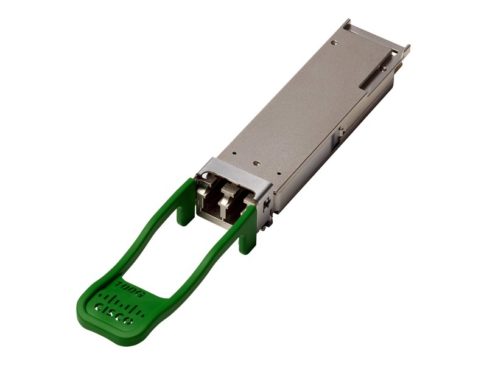
The Cisco QSFP-100G-CWDM4-S Module supports link lengths of up to 2 km over a standard pair of G.652 Single-Mode Fiber (SMF) with duplex LC connectors. The 100 Gigabit Ethernet signal is carried over four wavelengths. Multiplexing and demultiplexing of the four wavelengths are managed within the device.
- QSFP-100G-SM-SR – Cisco 100GBASE CWDM4 Lite QSFP Transceiver, 2km over SMF, 10-60C:

The Cisco QSFP-100G-SM-SR QSFP module supports link lengths of up to 2 kilometers over a standard pair of G.652 Single-Mode Fiber (SMF) with duplex LC connectors. The 100 Gigabit Ethernet signal is carried over four wavelengths. Multiplexing and demultiplexing of the four wavelengths are managed within the device. The operating temperature range is from +10 to +60°C with an optical link budget of 4.2 decibels. This 4.2-decibel link budget offers the ability to support the loss from patch panels in the link in a data center environment. QSFP-100G-SM-SR is interoperable with QSFP-100G-CWDM4-S.
- QSFP-100G-ER4L-S – Cisco 100GBASE QSFP Transceiver, 40KM reach over SMF, Duplex LC:
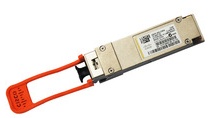
The Cisco QSFP100 ER4-Lite supports link lengths of up to 40km over a standard pair of G.652 single-mode fiber with duplex LC connectors. The 100 Gigabit Ethernet signal is carried over four wavelengths. Multiplexing and demultiplexing of the four wavelengths are managed within the device. Full 40km reach requires the use of FEC on the host platform. Without FEC, the reach is 30km. The QSFP100 ER4-Lite provides backward compatibility with Cisco’s CPAK ER4-Lite, whose reach is up to 25km, and with IEEE 100GBASE-ER4 standardized transceivers, such as Cisco’s CFP 100G ER4, up to 30km. It also interoperates with Cisco’s QSFP100 and CPAK IEEE 100GBASE-LR4 modules up to 10km.
- QSFP-100G-LR4-S – Cisco 100GBASE-LR4 QSFP Transceiver, LC, 10km over SMF:

QFSP Optics Modules SMF with MPO connectors:
- QSFP-100G-PSM4-S – Cisco 100GBASE PSM4 QSFP Transceiver, MPO-12, 500m over SMF:

The Cisco QSFP-100G-PSM4-S Module supports link lengths of up to 500 meters over SMF with MPO connectors. The 100 Gigabit Ethernet signal is carried over 12-fiber parallel fiber terminated with MPO multifiber connectors.
DAC (Direct Attach passive)
- Cisco QSFP-100G-CUxM – Cisco 100GBASE-CR4 QSFP Passive Copper Cable, from 1 to 5 meters:
 (Cisco QSFP-100G-CU1M, 1 meter)
(Cisco QSFP-100G-CU1M, 1 meter)
Cisco QSFP to QSFP copper direct-attach 100GBASE-CR4 cables are suitable for very short links and offer a cost-effective way to establish a 100-Gigabit link between QSFP-100G ports of Cisco switches within racks and across adjacent racks. Cisco currently offers passive copper cables in lengths of x=1, 2, 3 and 5 meters.
AOC (Direct Attach active)
- QSFP-100G-AOCxM – Cisco 100GBase QSFP Active Optical Cable, from 1 to 30 meters:
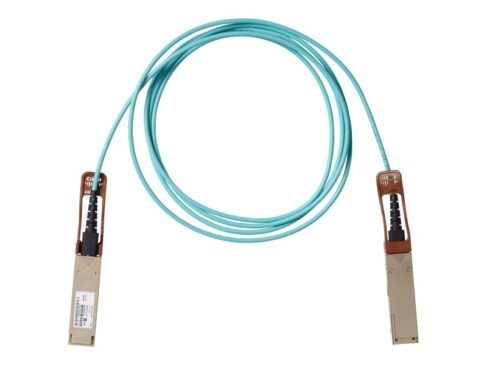
Cisco QSFP-100G to QSFP-100G AOC cables (Figure 4) are suitable for short distances and offer a flexible way to connect within racks and across racks. Active optical cables are much thinner and lighter than copper cables, which makes cable management easier. AOCs enable efficient system airflow, which is critical in high-density racks. Cisco currently offers active optical cables in lengths of x=1, 2, 3, 5, 7, 10, 15, 20, 25, and 30 meters
QSFP Splitter cables (Direct Attach passive)
- QSFP-4SFP25G-CUxM – Cisco 100GBase QSFP to 4xSFP25G Passive Copper Splitter Cable, from 1 to 5 meters:

Cisco QSFP-100G to four SFP-25G copper direct-attach breakout cables (Figure 2) are suitable for very short links and offer a cost-effective way to connect within racks and across adjacent racks. These breakout cables connect to a 100G QSFP port of a Cisco switch on one end and to four 25G SFP ports of a Cisco switch/server on the other end. Cisco currently offers passive cables in lengths of x=1, 2, 3 and 5 meters.
CFP
Cisco 100GBASE CFP Modules Data Sheet: https://www.cisco.com/c/en/us/products/collateral/interfaces-modules/transceiver-modules/data_sheet_c78-633027.html
- CFP-100G-LR4 – Cisco 100GBASE-LR4 CFP Module for SMF (<10 km):
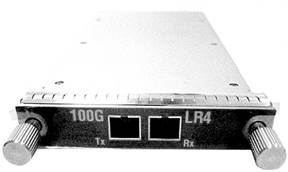
The Cisco 100GBASE-LR4 (above) CFP module supports a link length of 10 kilometers on standard single-mode fiber (SMF, G.652). 100 Gigabit Ethernet signal is carried over four wavelengths. Multiplexing and demultiplexing of the four wavelengths are managed within the device.
- CFP-100G-SR10 – Cisco 100GBASE-SR10 CFP Module for MMF (<100m OM3/< 150m OM4):
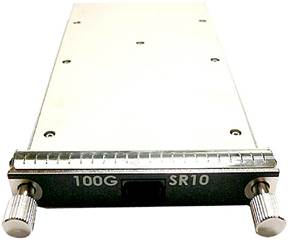
The Cisco 100GBASE-SR10 (above) CFP module supports link lengths of 100 meters and 150 meters respectively on laser-optimized OM3 and OM4 multifiber cables. It primarily enables high-bandwidth 100-gigabit links over 24-fiber ribbon cables terminated with MPO/MTP-24 connectors. It can also be used in 10 x 10 Gigabit Ethernet mode along with ribbon to duplex fiber breakout cables for connectivity to ten 10GBASE-SR optical interfaces. Maximum channel insertion loss allowed is respectively 1.9 dB over 100m of OM3 cable or 1.5 dB over 150m of OM4 cable.
- CFP-100G-ER4 – Cisco 100GBASE-ER4 CFP Module for SMF (<40 km):

The Cisco 100GBASE-ER4 (Figure 3) CFP module can support link lengths up to 40 kilometers on standard duplex single-mode fiber (SMF, G.652) terminated with SC/PC optical connectors. 100 Gigabit Ethernet signal is carried over four wavelengths. Multiplexing and demultiplexing of the four wavelengths are managed within the device. The Cisco 100GBASE-ER4 CFP module meets the IEEE 802.3ba requirements for 100GBASE-ER4 performance and also supports Digital Optical Monitoring (DOM) of the transmit-and-receive optical signal levels.
CXP
Cisco 100GBASE CXP Modules Data Sheet: https://www.cisco.com/c/en/us/products/collateral/interfaces-modules/transceiver-modules/datasheet-c78-734364.html
- CXP-100G-SR10 – 100GBASE-SR10 CXP Module for MMF compliant to 10GBASE-SR

The Cisco CXP 100GBASE-SR10 module (above) supports link lengths of 100m and 150m on laser-optimized OM3 and OM4 multifiber cables, respectively. The module delivers high-bandwidth 100-gigabit links over 24-fiber ribbon cables terminated with MPO/MTP-24 optical connectors. It can also be used in 10 x 10-Gb mode along with ribbon-to-duplex-fiber breakout cables for connectivity to ten 10GBASE-SR optical interfaces.
- CXP-100G-SR12 – 100GBASE-SR10 CXP Module for MMF
The Cisco CXP-100G-SR12 have the same specifications, but support breakout applications only for 40GBASE-SR4, not for 10GBASE-SR.
CPAK
Cisco CPAK 100GBASE Modules Data Sheet: https://www.cisco.com/c/en/us/products/collateral/interfaces-modules/transceiver-modules/data_sheet_c78-728110.html
CPAK Optics Modules SMF with SC or LC connectors:
- CPAK-100G-LR4 – 100GBASE-LR4 Cisco CPAK Module for SMF (terminated with SC Connectors)

- CPAK-100GE-LR4 – 100GBASE-LR4 Cisco CPAK Module for SMF (terminated with LC Connectors)

The primary application of the Cisco CPAK-100G-LR4 and CPAK-100GE-LR4 modules is to support 100Gbps optical links over standard Single-Mode Fiber (SMF, G.652) terminated with SC or LC connectors.
The LR4 modules are IEEE 802.3ba-compliant and supports link lengths of up to 10 km over standard SMF, G.652. It delivers an aggregate data signal of 100 Gbps, carried over four LAN Wavelength-Division Multiplexing (WDM) wavelengths operating at a nominal 25 Gbps per lane. Optical multiplexing and demultiplexing of the four wavelengths are managed within the module.
- CPAK-100G-ER4L – 100GBASE-ER4 Lite Cisco CPAK Module for SMF

The primary application of the Cisco CPAK-100G-ER4L module is to support 100-Gbps optical links over standard Single-Mode Fiber (SMF, G.652) terminated with SC connectors. Nominal power consumption is less than 7.5W.
The ER4 Lite module is compatible with the 100GBASE-ER4 standard and supports link lengths up to about 25 km over standard SMF, G.652. It delivers an aggregate data signal of 100 Gbps, carried over four LAN Wavelength-Division Multiplexing (WDM) wavelengths operating at a nominal 25 Gbps per lane. The module can be used over longer distances in engineered links with CPAK-100G-ER4L modules at both ends. Optical multiplexing and demultiplexing of the four wavelengths are managed within the module.
- CPAK-100G-CWDM4 – 100GBASE-CWDM4 Cisco CPAK Module for SMF

The Cisco CPAK-100G-CWDM4 Module supports link lengths of up to 2 km over a standard pair of G.652 Single-Mode Fiber (SMF) with duplex LC connectors. The 100 Gigabit Ethernet signal is carried over four wavelengths. Multiplexing and demultiplexing of the four wavelengths are managed within the device.
CPAK Optics Modules SMF with MPO connector:
- CPAK-10X10G-LR – 10x10G-LR Cisco CPAK Module for SMF

The Cisco CPAK-10X10G-LR module is used in 10 x 10Gb mode along with ribbon-to-duplex SMF breakout cables for connectivity to ten 10GBASE-LR optical interfaces. It supports link lengths up to 10km over standard SMF, G.652. The module delivers 100-Gbps links over 24-fiber ribbon cables terminated with MPO/MTP connectors.
- CPAK-10X10G-ERL – 10x10G-ERL Cisco CPAK Module for SMF

The Cisco CPAK-10X10G-ERL module is used in 10 x 10Gb mode along with ribbon-to-duplex SMF breakout cables for connectivity to ten 10GBASE-ER optical interfaces. It supports link lengths up to 25km over standard SMF, G.652. The module delivers 100Gbps links over 24-fiber ribbon cables terminated with MPO/MTP connectors.
- CPAK-100G-PSM4 – 100GBASE PSM4 Cisco CPAK Module for SMF
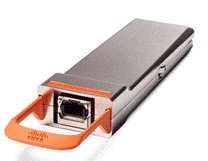
The Cisco CPAK-100G-PSM4 Module supports link lengths of up to 500 meters over Single-Mode Fiber (SMF) with MPO connectors. The 100 Gigabit Ethernet signal is carried over 12-fiber parallel fiber terminated with MPO multifiber connectors.
CPAK Optics Modules MMF with MPO connector:
- CPAK-100G-SR10 – 100GBASE-SR10 Cisco CPAK Module for MMF

The Cisco CPAK-100G-SR10 module delivers 100-Gbps links over 24-fiber ribbon cables terminated with MPO/MTP connectors. It can also be used in 10 x 10Gb mode along with ribbon-to-duplex-fiber breakout cables for connectivity to ten 10GBASE-SR optical interfaces. It supports link lengths of 100m and 150m on laser-optimized OM3 and OM4 multifiber cables, respectively.
- CPAK-100G-SR4 – 100GBASE-SR4 Cisco CPAK Module for MMF
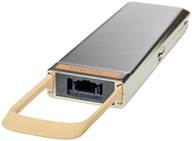
The Cisco CPAK-100G-SR4 Module supports link lengths of up to 70m (100m) over OM3 (OM4) Multimode Fiber with MPO connectors. It primarily enables high-bandwidth 100G optical links over 12-fiber parallel fiber terminated with MPO multifiber connectors. CPAK-100GE-SR4 supports 100GBase Ethernet rate.

More information and Cisco compatibility matrix
The Cisco Transceiver Module Group (TMG) Compatibility Matrix is an excellent source of information.
The Cisco entire list of 100Gb Ethernet modules: https://www.cisco.com/c/en/us/products/interfaces-modules/100-gigabit-modules/index.html
Wikipedia 100Gb standard: https://en.wikipedia.org/wiki/100_Gigabit_Ethernet
